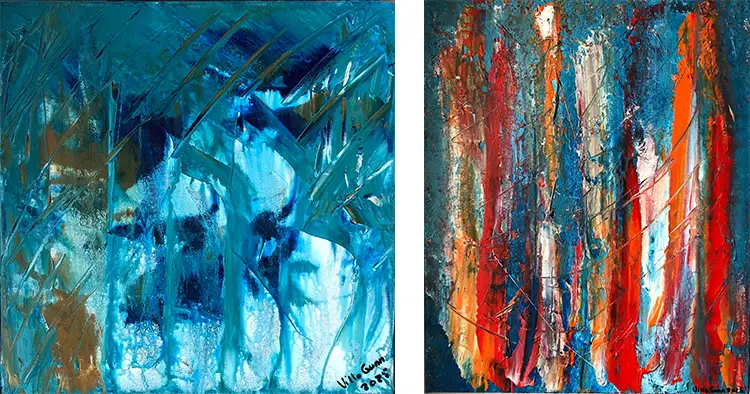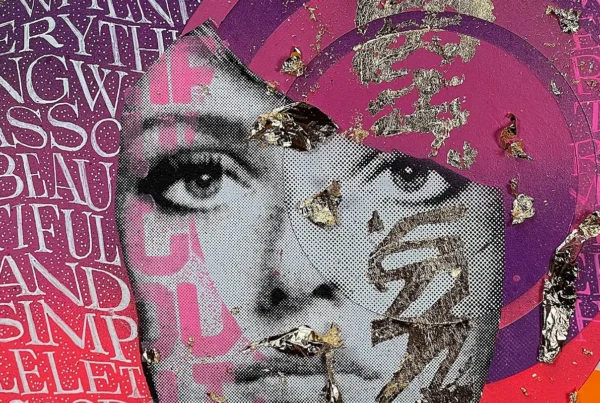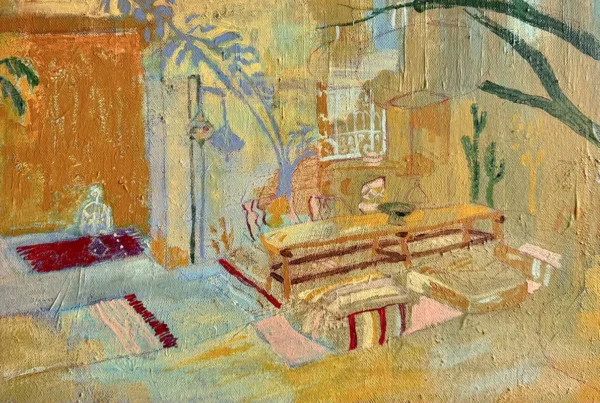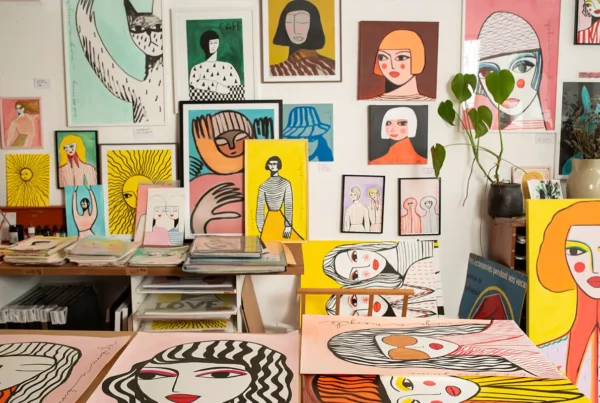“I answered the question what are you going to do before you die — and I chose to become an artist.”
Nature, Protest, and the Pulse of a New Life
At once quiet and defiant, the work of Vilborg G. Hansen emerges from a lifetime of watching, listening, and responding to the world around her. Born and raised in Reykjavík, Iceland’s capital, Hansen was always drawn to the quiet vastness beyond the urban sprawl. The rugged landscapes of Iceland not only offered her sanctuary, but also a place to contemplate societal issues that stirred her deeply—human rights violations, systemic injustice, and political corruption. A lifelong critic of inequality, Hansen found that her most authentic means of expression came not through speeches or debates, but through the evocative movement of paint across canvas. Her art is not simply visual—it is visceral, pulsing with her inner convictions and marked by an honesty that refuses to compromise.
Although her early years were marked by a keen interest in current affairs and a brief foray into politics, Hansen ultimately found conventional routes of change insufficient. The limitations of the political world drove her to channel her frustrations and hopes into art. Her pieces are shaped by the emotional momentum of the moment—a spontaneous, flowing process that mirrors her personal experiences and evolving state of mind. Rather than seeking clarity or consensus, Hansen invites ambiguity. Her viewers are free to interpret her work through their own lenses, yet she finds a quiet joy when others see what she sees, feel what she feels. For her, the uniqueness of every observer enriches the dialogue her artwork ignites.
What catalyzed her full immersion into the art world was not a gradual shift but a near-death experience. Two years ago, Hansen suffered a cardiac arrest, a moment that radically reframed her sense of purpose. No longer preoccupied with practicality or external approval, she asked herself what legacy she wished to leave behind. The answer was simple but transformative—she would dedicate her life to the art she had been discouraged from pursuing. Enrolling in courses led by globally respected abstract artists, she absorbed technique not as a destination but as a foundation. From there, she broke away and forged her own path, unbound by convention and fueled by the urgency of the times.
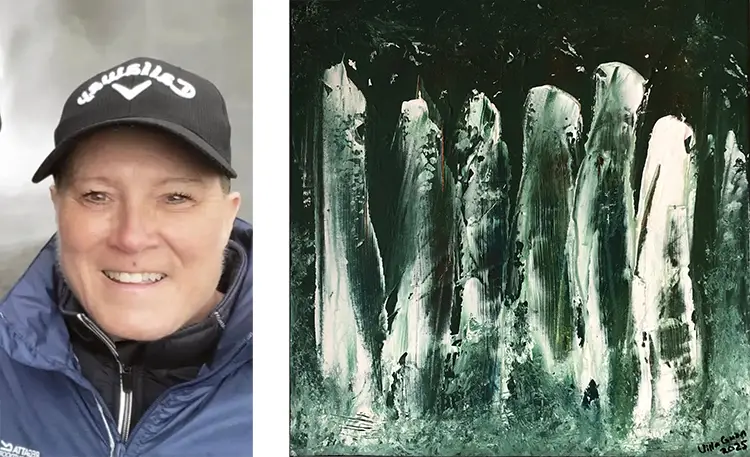
Vilborg G. Hansen: Painting the Unspoken Truth
Within Hansen’s creative process lies a distinctive rhythm, one that relies less on traditional methods and more on emotional impulse and technical improvisation. She never uses brushes, preferring instead to lay her canvas flat and work from above. Water becomes an essential collaborator in her compositions, guiding pigment in unpredictable patterns that often mirror the chaos or harmony she seeks to convey. This horizontal method fosters a sense of physical intimacy with her work; the painting is not a distant object on an easel but a surface to be walked around, poured over, and physically connected to. This approach yields an organic rawness in her pieces—gestures of thought made visible, meditations made material.
Thematically, Hansen’s work oscillates between pain and possibility. War, forced migration, systemic injustice, and spiritual symbolism frequently dominate her mental and visual landscapes. Yet alongside this darkness, she also seeks out traces of light—glimpses of human decency, spiritual resilience, and shared energy that exist even in fractured times. Her paintings function as both warning and reminder, capturing not only what is wrong but what might still be right with the world. Religious imagery and universal symbols often emerge in her work, not to preach, but to highlight the connections that lie beneath difference—a quiet advocacy for empathy in an increasingly polarized era.
Among her most meaningful creations is the painting The Choir. In this work, a conductor stands at the heart of the canvas, enveloped by the surrounding presence of a choir, while an ethereal quality seems to radiate outward, invoking the sanctity of a cathedral. For Hansen, this piece touches something sacred, suggesting a unity that transcends language or geography. It is no surprise that The Choir has been selected for publication in a 2025 volume dedicated to the Leonardo Da Vinci Prize by the Effetto Art Foundation, under the curatorship of Salvatore and Francesco Russo. This recognition not only affirms Hansen’s place in the contemporary abstract art scene but also highlights the emotional resonance her work carries across cultural and national boundaries.
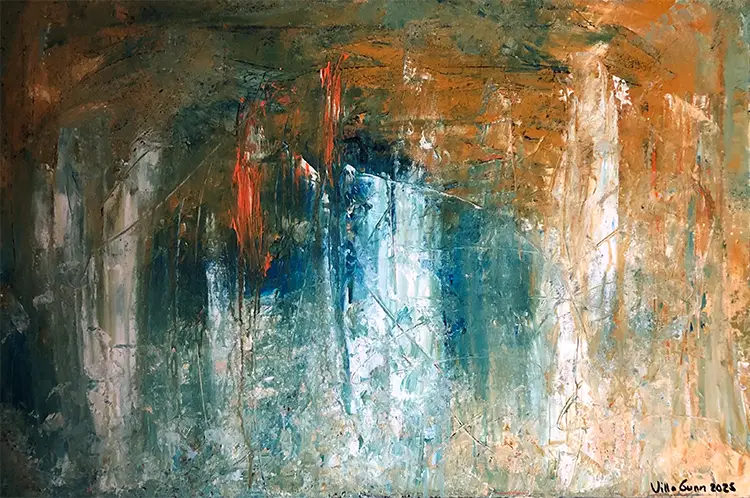
Art as a Wake-Up Call
Despite gaining international recognition and awards in recent years, Hansen’s ambitions remain grounded in a singular, profound desire: to be understood. Her works are less about showcasing technical mastery and more about urging viewers to pause, question, and feel. She does not craft narratives with easy conclusions but instead offers fragments of thought—visual cues that echo the instability and hope that characterize our world today. In paintings like The Wall Between Us and We Are All the Same, she directly confronts themes of division and shared humanity, capturing the urgency of her message with striking simplicity and emotional depth. These works are not meant to soothe; they are meant to stir.
In Hansen’s eyes, art has the potential to rattle the collective consciousness from its complacency. She hopes her creations become mirrors—uncomfortable at times, but necessary. Her vision is not limited to gallery walls or art fairs; it extends to the social fabric itself. She dreams of a time when more people choose reflection over judgment, when empathy replaces fear, and when peace is pursued not as an abstract ideal but as a practical necessity. Through her abstract visuals, she articulates these ambitions without didacticism, allowing her viewers to arrive at their own revelations.
Although she has no specific long-term projects outlined, Hansen’s creative impulse remains persistent. Her studio setup is strikingly unorthodox, often consisting of little more than a kitchen table. What she requires above all is solitude—an uninterrupted space where thought and energy can flow freely. Often rising before dawn or waking in the middle of the night with a compulsion to paint, she resists anything that might disrupt the fragile momentum of inspiration. The studio, with its formal rituals and potential distractions, can feel too distant. Instead, she opts for immediacy, proximity, and above all, authenticity in how and where her work is born.
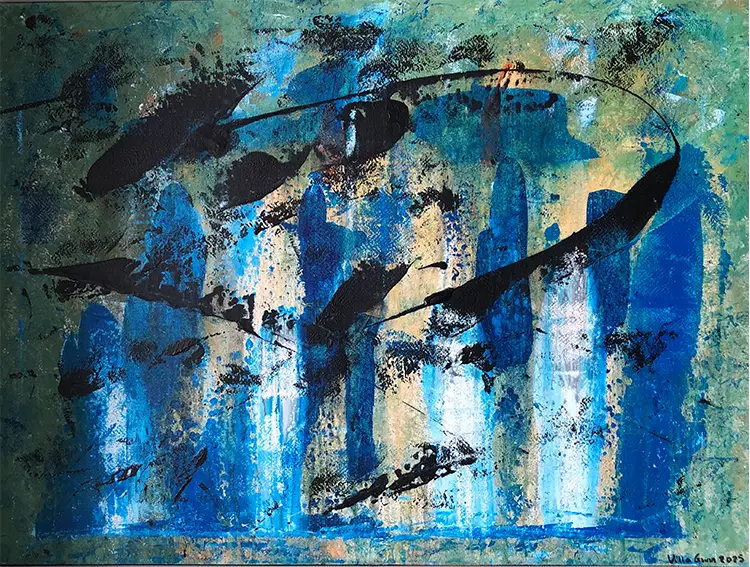
Vilborg G. Hansen: Flowing Against the Current
At the core of Hansen’s artistic evolution lies a deep appreciation for learning, coupled with a relentless drive to redefine herself. Her choice of acrylics was not immediate but instinctive; after experimenting with other media, it quickly became clear that this medium provided her the control and expressive freedom she craved. With acrylics, she discovered not only technique but voice—a way to translate complex emotions and unspoken thoughts into dynamic visual experiences. The medium responds swiftly, matching the pace of her thought process, and accommodates the water-based manipulation she favors. It allows her to capture fleeting moments of emotional clarity before they dissipate.
While grounded in her personal vision, Hansen’s stylistic development has been shaped in part by the work of artists she admires. Gino Savarino and Suraj Patel have influenced her technique, especially in their use of color and movement within abstract compositions. She also acknowledges the impact of artists like Gerhard Richter, whose range and complexity resonate with her own practice. However, Hansen does not seek to mimic; she absorbs and adapts, letting inspiration serve as a starting point rather than a blueprint. Her achievements over the past two years—marked by international awards—signal not only external recognition but also a deeper internal validation. She has found where she belongs.
Despite the acclaim and the growing audience for her work, Hansen remains focused on the essence of her mission: to speak honestly through her art. She does not view success as a destination but as a signpost that she’s moving in alignment with her values. Every piece she creates is an act of resistance, a call for awareness, and an offering of hope. In times of division and turmoil, Hansen’s abstract canvases suggest that even in abstraction, there is clarity to be found—if one is willing to look closely enough.
